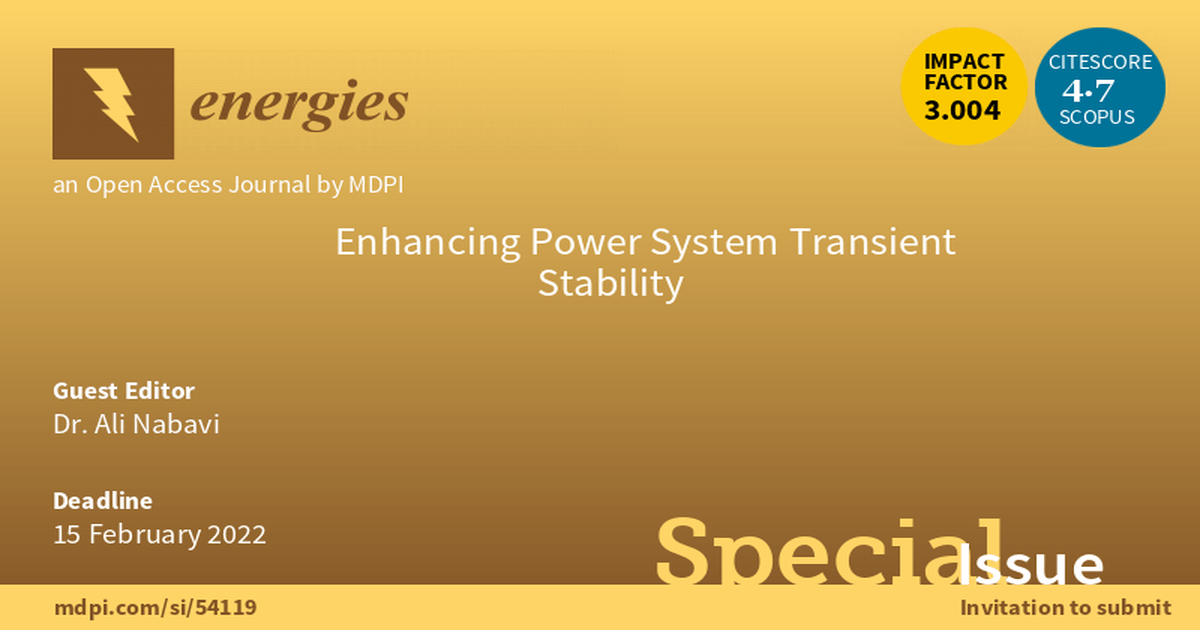- 3.2Impact Factor
- 7.3CiteScore
- 17 daysTime to First Decision
Enhancing Power System Transient Stability
This special issue belongs to the section “F1: Electrical Power System“.
Special Issue Information
Dear Colleagues,
In an effort to modernize the electrical grid, electric power systems are integrating new transmission and distribution technologies such as synchrophasors, fast excitation systems, FACTS devices, distributed smart inverter-based solar, wind generators, and battery storage with advanced controls, resulting in a better observable and controllable end to end power grid. Enhancing transient stability is a primary concern for electrical engineers to maintain the continuous operation of power systems.
Massive deployment of long distance HVDC lines move large amounts of power from remote areas to densely populated load centers. This combination of electronics-based power controllers, and faster wide-area monitoring systems generate new opportunities to enhance power system transient stability. This Special Issue invites experts from around the world to report about recent applications aiming at enhancing power system transient stability through supplementary control of electronics-based power transmission, distribution, and renewable generation systems.
This Special Issue aims to bring together innovative developments and synergies in the field of enhancing power system transient stability.
Submit your paper and select the Journal “Energies” and the Special Issue “Enhancing Power System Transient Stability” via: MDPI submission system. Please contact the special issue editor (spring.deng@mdpi.com) for any queries. Our papers will be published on a rolling basis and we will be pleased to receive your submission once you have finished it.
Dr. Ali Nabavi
Guest Editor
Manuscript Submission Information
Manuscripts should be submitted online at www.mdpi.com by registering and logging in to this website. Once you are registered, click here to go to the submission form. Manuscripts can be submitted until the deadline. All submissions that pass pre-check are peer-reviewed. Accepted papers will be published continuously in the journal (as soon as accepted) and will be listed together on the special issue website. Research articles, review articles as well as short communications are invited. For planned papers, a title and short abstract (about 250 words) can be sent to the Editorial Office for assessment.
Submitted manuscripts should not have been published previously, nor be under consideration for publication elsewhere (except conference proceedings papers). All manuscripts are thoroughly refereed through a single-blind peer-review process. A guide for authors and other relevant information for submission of manuscripts is available on the Instructions for Authors page. Energies is an international peer-reviewed open access semimonthly journal published by MDPI.
Please visit the Instructions for Authors page before submitting a manuscript. The Article Processing Charge (APC) for publication in this open access journal is 2600 CHF (Swiss Francs). Submitted papers should be well formatted and use good English. Authors may use MDPI's English editing service prior to publication or during author revisions.
Keywords
- Hybrid AC/DC microgrid
- FACTS
- Real-time digital simulation
- Lyapunov method
- Power systems stabilizer
- Wide-area measurements

Benefits of Publishing in a Special Issue
- Ease of navigation: Grouping papers by topic helps scholars navigate broad scope journals more efficiently.
- Greater discoverability: Special Issues support the reach and impact of scientific research. Articles in Special Issues are more discoverable and cited more frequently.
- Expansion of research network: Special Issues facilitate connections among authors, fostering scientific collaborations.
- External promotion: Articles in Special Issues are often promoted through the journal's social media, increasing their visibility.
- e-Book format: Special Issues with more than 10 articles can be published as dedicated e-books, ensuring wide and rapid dissemination.

